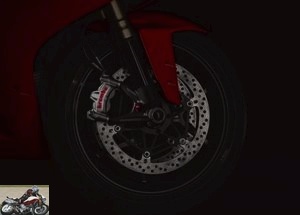Menus
- Beauty is the beast
- Ducati’s new flagship is a phenomenal machine. Sleek, overpowered, overflowing with torque and fitted with the latest electronics, it is undoubtedly the most sensational machine of the moment. As long as you know how to tame it…
- Part-cycle
- Motor
- Electronics
- Braking
- Dashboard
- The rest…
- In the saddle
- On track
- Conclusion
- The assayer’s equipment:
Beauty is the beast
Ducati’s new flagship is a phenomenal machine. Sleek, overpowered, overflowing with torque and fitted with the latest electronics, it is undoubtedly the most sensational machine of the moment. As long as you know how to tame it…
Ah the little phrases … If a guy wearing a Ducati t-shirt says to you: "The Panigale 1299 is the best twin-cylinder Superbike ever built!" », You will tell yourself (rightly) that he is only repeating the pretty speech concocted by the Marketing and Communication department of the Bologna firm.
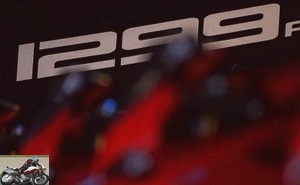
But when it’s Claudio Domenicali, Ducati’s supreme boss since 2013, who smiles this little phrase during his introductory speech to the international press, we are already more inclined to believe it … The man knows What he is talking about since, in addition to his training as an engineer, he successively managed the brand’s racing department (1999), the Research and Development branch (2005) and then the Product Development activity (2009). The message is all the stronger as Domenicali recognizes without language of wood that the previous generation of Panigale – the 1199 – was not free from faults, with in particular an engine suffering from a chronic lack of torque at mid-speed for a twin with such a large displacement.
With this 1299, which arrives very early in a classic development cycle, Domenicali wants to send a strong message: the takeover by Audi and the Volkswagen group will "neither transform Ducati into a generalist manufacturer, nor dilute the brand’s philosophy. ". On the contrary, the arrival of “fresh” capital is used here to “develop and produce the best machines in their segment” !

Part-cycle
On the Ducati technical side, the evolution from 1199 to 1299 was articulated around 5 key points: lightness, power, technology, design and performance. On the chassis side, we therefore find an aluminum monocoque structure which attaches to a V2 Superquadro contributing to the rigidity of the whole. The front part, which still acts as an air box, has seen its caster angle go from 24.5 ° to 24 ° while the caster is reduced from 100 to 96 mm. At the rear, the swingarm anchor point is lowered by 4 mm. The wheelbase is given for 1.437 mm with a weight distribution of 52% on the front. On the scale, Ducati announces a slight increase in dry weight with 166.5 kg (+ 2.5 kg) and 179.5 kg without gasoline. The R version, not available during our presentation, should weigh only 173 kg !
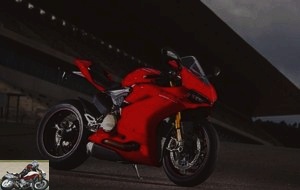
Motor
To counterbalance this slight overweight, the V2 has seen its capacity revised upwards. With a bore increasing from 112 to 116 mm and an identical stroke of 60.8 mm, the Superquadro (for supercar) now cubs 1,285 cm3 with a compression ratio increased to 12.6: 1. The admission does not change, we therefore find oval ducts with an unchanged “diameter” surmounted by butterflies controlled by a ride by wire as well as two injectors per duct. The first, located under the throttle operates permanently while the second, housed above, is only used at full load and high in the towers. In the end, the output climbs from 195 to 205 horsepower, all obtained at a speed of 10,500 rpm. However, Ducati denies having wanted to increase the power, the priority in the engine development having been given to the couple, this one passing from 13.5 to 14.5 mkg. Beyond the gain in absolute value, the practical range of use has been considerably widened with a torque increase of more than 15% between 5 and 8,000 rpm.
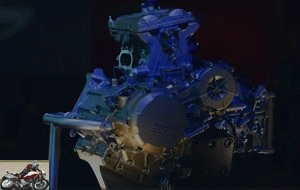
Electronics
The 1299 Panigale is entitled to the cream of the crop when it comes to electronics. Most of the systems are coupled with a new Inertial Measurement Unit (IMU) 9.1 from Bosch which continuously analyzes the acceleration and movements applied to the machine on three axes (vertical, longitudinal and transverse). More efficient and lighter by a kilo, this IMU has thus made it possible to introduce a new function: Cornering ABS capable of managing the braking power according to the angle taken by the machine. The IMU also allows finer management of wheeling control (DWC, Ducati Wheeling Control). As for the S versions of the Panigale, fitted with Ohlins piloted suspensions, this IMU makes it possible to harmonize the hydraulic control between the fork and the rear shock absorber during the various piloting phases (acceleration, braking, net gas on the angle, etc) while offering as before 5 different calibrations at the front and at the rear. As a cherry, we can also play on the hardness of the steering damper.
Another novelty, the DQS (Ducati Quick Shifter) now works up and down gears without the aid of the clutch, giving itself the little gas that goes well (thank you the ride by wire) when downshifting so as not to destabilize the machine. Let’s not forget the other driving aids inherited from the 1199, also improved, such as the DTC (Ducati Traction Control) adjustable on 8 levels or disconnectable, or the EBC (Engine Brake Control) capable of modulating the amount of engine braking. (3 positions). To limit migraines, everyone is paired with Ducati Riding Modes. The rider therefore has a choice of Wet, Sport and Race, each pre-defining specific settings for DTC, DWC, EBC and ABS. You always follow ?
Without going into details, let’s just add that in Race, the Cornering ABS function is deactivated – as well as the ABS at the rear – and that the power is limited to 120 horsepower in Rain mode. It is possible to switch from one mode to the other while driving but to validate the selection, it is imperative not to touch either the accelerator or the brakes, both being controlled by the IMU control unit … can of course put each mode to its sauce by independently modifying each parameter in a sub-menu displayed on the TFT dashboard via an interface a bit obscure for a neophyte. Needless to say, the complexity of the exercise requires being at a standstill. People in a hurry, trackers and lazy can fall back on the S version. It has two additional buttons (+ and -) on the left stalk to modify the DTC, the DWC or the EBC while driving..
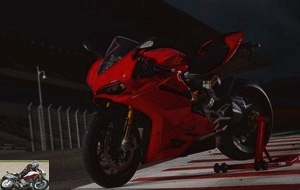
Braking
All 1299s, from “normal” to R, are entitled to Brembo M50 4-piston radial calipers. One-piece type, they are both lighter and more compact than traditional models. They are mated to two 330 mm diameter discs at the front. At the rear, it’s not bad either with a 2-piston caliper and a large 245mm disc. Everything is under the supervision of a Bosch 9.1 central controlling the latest generation of ABS integrating the new Cornering ABS function (deactivated in Race mode), managing the power according to the angle taken by the machine.
Dashboard
Already mentioned above, the dashboard’s HD screen is made from TFT (Thin Film Transistor, ultra-flat version of the LCD), a technology used on some computers, smartphones and tablets. In addition to the fact that its brightness adapts to the ambient light, the color of the interface can be configured as desired. The upper part shows the time as well as the engine speed. On each side, a bar integrates the usual warning lights (indicators, reserve, oil level, etc.). The lower part displays the driving mode chosen as well as the setting of each assistance. In the center, the gear engaged, the speed and in two specific windows are displayed the countless classic information from an on-board computer, from the partial trip to the average speed through the instantaneous consumption. In Race mode, it is even possible to view the angle degrees (with storage of the maximum angle) as well as the lap time! For professionals and track day enthusiasts, Ducati sells an optional data acquisition system coupled with a GPS. This device makes it possible to memorize a virtual zone acting as a start / finish line, automatically triggering a lap-by-lap stopwatch as well as the recording of data managed by the IMU, all of which is then stored in a USB key housed under the saddle then viewable on a PC. Ah! I was going to forget … A chip (and probably a few sensors) is able to detect whether the size of the tires (slick?) Or the final gear ratio in order to automatically correct the data processed by the IMU and displayed on the dashboard. Phew…
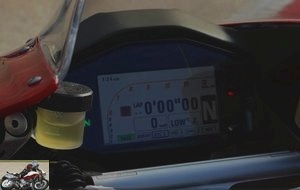
The rest…
History to differentiate the Panigale 1299 from the 1199, Ducati has cracked small aesthetic alterations. The rear shell has been refined and the look is adorned with LED lighting on the S version. We must also mention a specific pneumatic fit, Pirelli Diablo Supercorsa SP in 120/70 at the front and 200/55 at the back. As part of our test, carried out on the Portuguese track in Portimao, we were treated to an even more efficient ride, the SC2s, which are more like recut slicks although they are approved for road use..

In the saddle
The driving position is less drastic than it looks. Admittedly, we are tilted more forward than with a BMW S1000 RR and the footrests are further back, but this should not make it unliveable in the context of road use. The tank is extremely thin at the level of the crotch which allows my meter seventy to almost put both feet flat despite a saddle height of 830 mm. The stems are easily adjustable thanks to micrometric screws and the consistency of the clutch is surprisingly flexible given the torque it has to absorb. The mirrors even have the good taste of reflecting what is going on behind the pilot over most of their surface. As with all replica superbikes, the practicalities are not plentiful and operating the sidestand requires some twisting of the left ankle. No, the only irritating detail comes from the footrests, whose protruding tip of the side protection plates has proved incompatible with several models of racing boots, sometimes blocking the movement of the foot by getting caught in a seam or a bulge….
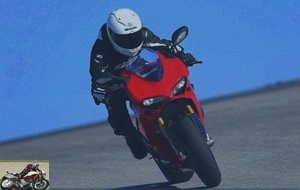
On track
Without going so far as to say that the handling of this Panigale 1299 is disconcertingly easy, the first turns of the wheel – in Sport mode – quickly build confidence. It is also not worse since the Portimao track is not easy. A kind of cross between Ledenon for its vertiginous drop in height and its blind turns and Dijon for the overall speed and the big curves, it is not easily tamed. Fortunately, the 1299 is on the alert.
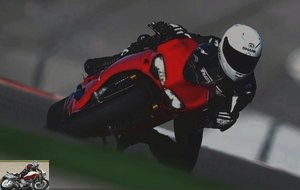
You change gears without worrying about the clutch, Brembo braking exudes delirious power and divine feeling and ABS Cornering offers the assurance of never “crossing your skis” when entering a turn. On the way out, the anti-skating and anti-wheeling duo will manage everything for you. Better, one can be mistaken of one, even two reports while entering a turn as the twin Superquadro has the resource. This is also the most glaring difference with the 1199 which could remain stuck at the exit of the curve if we had not selected the right gear. In short, everything is easy … as long as you stay below the 8,500 rpm mark.
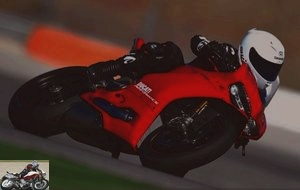
Beyond this threshold, the thrust is so strong that we hesitate to keep the full load … and there are a little more than 2000 turns before the breaker! The following sessions, in Race mode and more permissive driving aids, then show the true face of the 1299. Easy when winding, it becomes bestial as soon as you want to ride at a high pace. Already, ergonomics require a specific user manual. The insufficient grip of the saddle and the narrowness of the reservoir make braking phases almost problematic. Without much to tighten with the legs, we must systematically shift in a kind of pre-swaying so as not to be subjected to the full force of the braking on the forearms. If there is nothing disturbing in the tight turns (it is even recommended in flight school), it becomes more complicated when you reach almost 300 km / h at the end of the line … Fortunately, there is a way. to improve things (a little) with the Alcantara saddle from the Ducati Corse catalog. Now let’s talk about the acceleration phases. If you are 6 feet tall you will be fine. For the little ones, you will need a “Dany Pedrosa” saddle wedge to prevent you from pulling on the handlebars during strong acceleration. Since the Panigale is capable of wheeling even in sixth gear, this is a case that happens more often than you might think. Fortunately, the footrests are far enough back to counteract the phenomenal thrust of the twin with his legs, but for my part, the price to pay was a start of cramps after 15 minutes of driving. In short, it’s brutal.
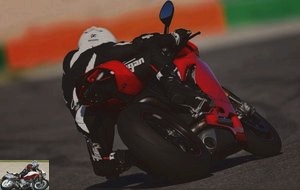
Not enough to question the effectiveness of this 1299, quite the contrary. It is enough to take a wind by the pilot of development, a blow in sliding of the two wheels, again the elbow on the ground, to understand that this machine is a weapon when one has the level. For an average pilot who does not practice the track in an assiduous manner (me, therefore), taking the 1299 requires concentration, application and a physical commitment at all times..
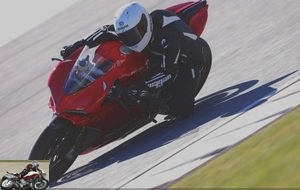
By lowering the pace a little and rolling "with your hand", you benefit from a demonic precision front end and an incredibly agile chassis in tight bends. And in large curves, the electronics play their role perfectly and in complete transparency. By flirting a few times with the limit, we discern out of the corner of our eye a flashing on the dashboard signifying that one of the systems is working for you. The electronic fairy also gently calms the game in case of excess optimism with the throttle grip. Which happens quite often at the end of the day. During my final session, I got used to the surge of power and torque a bit while being surprised to see the front wheel rear up in the straight line just after having engaged in sixth gear. !
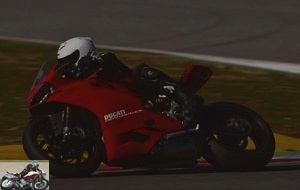
And the feeling that shines through is that, unlike its direct competitors, the Panigale 1299 is above all a racing bike whose behavior would have been slightly watered down. Its philosophy is diametrically opposed to the Total Control dear to Honda. To the ease of driving a CBR 1000 RR, it opposes a machine that needs to be tamed, or even tamed. A bestial engine in an ultra-rigid and demanding chassis, such is the mix offered by the Panigale 1299 to those who want to exploit its full potential. Here, the electronic aids are there to help the rider stay on his wheels rather than helping him go faster than he could. In return, the sensations it exudes are second to none..
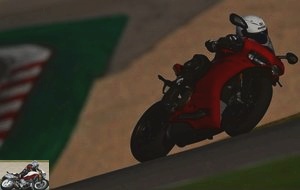
Conclusion
By becoming 1299, the Panigale wins on all fronts. The improvements made to the chassis are significant and its new V2 is now as brimming with torque as it is power. As for driving aids, it is quite simply the best available today. So what to blame him? Nothing on paper … except perhaps a price as always elitist: a standard version is negotiated at 20,990 € and the price rises to 25,990 € in version S with its piloted suspensions. Afterwards, you have to deal with the hardened steel character of the beautiful and its fabulous V2. At first easy, it will require a solid level of piloting to get the most out of it. You have been warned…
Strong points
- Racing motorbike
- Fatal Beauty
- Bewitching engine
- Overall efficiency
- Embedded technology
Weak points
- Racing motorbike
- Beginners refrain
- Ergonomics to refine
The technical sheet of the Ducat Panigale 1299
The assayer’s equipment:
- Shark Race-R Pro Helmet
- Furygan Dark Apex Jumpsuit
- Furygan Fit-R Gloves
- Forma Mirage Boots
Related articles
-
Ducati Panigale V4 S motorcycle test
The price of the exception V4, 1103 cm3, 214 hp and 124 Nm, 195 kg all full facts, 28,890 euros The bike that was being born was obviously exceptional:…
-
Ducati Panigale V2 motorcycle test
Mini-V4, maxi-pleasure? Controlled origin flavor V-twin Superquadro 955 cm3, Euro5, 155 hp and 104 Nm, 176 kg dry, 18,290 euros Family culture obliges,…
-
4 cylinders in V, 1103 cm3, 214 hp at 13,500 rpm, 124 Nm at 10,000 rpm, 195 kilos with full tank, from € 27,990 This V4 wants to cut the cards in the…
-
The best, quite simply 998 cc V4, 221 hp (234 hp) and 112 Nm, electronics and ride-by-wire, aerodynamic fairing, 193 kg full facts, 39,900 euros 2019…
-
A power cruiser with Italian sauce. Punch, style, noise, character ! V2 1262 cm3, 152 hp at 9,500 rpm, 12.8 m / kg at 5,000 rpm, 220 kilos dry, from…
-
Ducati Multistrada Enduro test
160 hp at 9,500 rpm, 13.9 m / kg at 7,500 rpm, 4 driving modes, 257 kilos, € 21,390 A super sophisticated sports trail with proven versatility Let no one…
-
A queen who treats you By their personality, their characteristics and their performances, the Ducati have always been motorcycles apart. La Panigale is…
-
Evolution of the 899 Evolution of the 899, the Ducati 959 Panigale is the manufacturer’s first Euro4 sports car. Intrusive, the standard imposes its…
-
Ducati Streetfighter V4 S motorcycle test
Super power inside 4 cylinders in V at 90 ° Desmosedici, 1,103cm3, 208 hp at 12,750 rpm, 178 kg dry, 22,990 euros Everyone knows the Mostro, which has…
-
Fine-tuning in order You don’t change a recipe that works. The second generation of the Ducati Diavel therefore evolves only on points of detail while…
